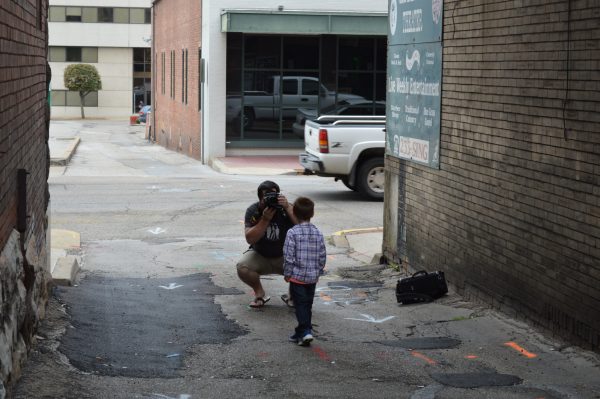By Steve Novotney
(Editor’s Note: This is the first of a two-part series examining Wheeling’s top news stories during 2014. The Part 2 will appear on New Year’s Day.)
It has been a year that has provided many forms of “Do Something” progress for the residents of the city of Wheeling thanks to several partnerships involving members of the community and government officials.
Private development took place, too, in several sections of the Friendly City. In fact, many insist there is forward momentum in the downtown for the first time in several decades. Building purchases and renovations have attracted new businesses to an area on the decline since the 1970s, and generations have connected to allow for hope – finally – for real revitalization.
In no particular order, here is a listing of some of the top stories for the city of Wheeling in 2014. Please feel free to add to this listing via the “Comment” option at the bottom of the page.
Recycling the City’s Recycling Program
Although the city of Wheeling has implemented several “green” initiatives, the municipality’s residents are not offered much of an opportunity to recycle. However, that could change in the near future, according to a few of the city’s leaders.
City Manager Robert Herron confirmed the city’s recycling program is lacking, and a partnership with the private sector is a consideration. Scott Ludolph, owner of Scrappy Pappy’s Recycling in East Wheeling, plans to address city council in an effort to make that partnership become a reality in 2015.
“I would like to see Wheeling become the greenest city in West Virginia, and I would like to see the people of Wheeling be proud of its recycling program,” Ludolph told Weelunk in mid-December. “If you ask people why they don’t recycle, there are usually two reasons: It’s a pain in the rear; and they don’t know if the materials will actually be recycled. Well, I can tell people that if I am involved, at least 97 percent of what they put out will be recycled.”

The Future Fate of the Aetnaville Bridge
Officials with the West Virginia Division of Highways informed Wheeling leaders in early November that the demolition of the Aetnaville Bridge was on the state’s “To Do” list. Although the DOH’s Dan Sikora did not provide specific dates or details, he did confirm that the sandstone supports would be left standing so a pedestrian/bike bridge could be constructed in the future.
Dave Sada, the director of the Bridge Department for DOH District 6, said the span could be sold for as little as a dollar if a prospective owner presented a viable plan for preserving the Aetnaville Bridge.
The bridge, which opened in 1891 as a span for buggies and pedestrians over the back channel of the Ohio River, connects on the North End of Wheeling Island to the Aetnaville section of the Village of Bridgeport, Ohio. It was designed by the Wrought Iron Bridge Company of Canton, Ohio, and it includes four spans, three pier supports, and measures 440 feet in length.
Sada confirmed that the bridge was closed to vehicular traffic in 1988 because of safety concerns.
A community group familiar with the span organized a petition to stop the demolition of the Aetnaville Bridge, but the group has not approached the DOH concerning a possible purchase. Sada said the demolition will likely not occur in 2015 because of the many other projects on the state’s priority list for the northern panhandle.
Little-Known Effort an Example of Caring Coaches
Sweatpants and hoodies. I-Pads and clipboards.
It’s a room full of football coaches, after all.
There’s no posted agenda. But there is one goal.
More than 30 football coaches from the Ohio Valley Athletic Association sat down with college recruiters in early December at Generations Restaurant and Pub in an effort to gain attention for their graduating student/athletes.
According to Mike Young, head football coach and athletic director at Wheeling Central Catholic High School, this event takes place twice per year thanks to the Ohio Valley Football Coaches Association.
“About 40 years ago, coaches like George Strager (St. Clairsville) and Bud Billiard (Brooke High) started holding these evenings, and they wondered then if the younger coaches like I was at the time would have enough initiative to keep it going,” Young told Weelunk. “It was important to them, and it’s important to us, and that’s why we continue making these efforts.
“We hold one evening for our graduating seniors who haven’t been on the recruiting radar, and then in either late April or early May, we hold another forum for our student/athletes who will be juniors and seniors next year.”
The coaches association reaches out to NCAA Division II and Division III schools that are located in Ohio, West Virginia, and Pennsylvania. Colleges and universities that have sent representatives previously, including West Liberty University, Washington & Jefferson College, Dennison, Erie, Allegheny, Mount Union, Capitol, Waynesburg, Wooster, Heidelberg, and Mercyhurst.
“There are a lot of players in the OVAC that deserve a chance to continue their playing career while getting that all-important college education. That’s what this is all about,” Young added. “They may not be the young men who are big enough or strong enough to play Division I, but they are the players who have great work ethics and the heart to continue playing on the next level.”
“Superloads” and the Gas and Oil Industries
The growth of the fracking industry continued in the Wheeling area throughout 2014, and the delivery of a pair of “Superloads” to Williams Energy’s Oak Grove facility in Marshall County was one of the highlights for local, sightseeing residents.
The city of Wheeling has collected more than $500,000 over the past three years via the joint lease agreement with the Wheeling Park Commission for exploration and harvesting beneath Oglebay Park. Herron expects that dollar figure to grow in 2015 since more wells are planned for the pads established by Chesapeake Appalachia.
“The city receives between $18,000 and $20,000 per month in royalty payments,” Herron said. “Those funds are going into our (Restricted Capital Improvements) account. We will buy an ambulance with those funds and will make other capital improvements with those funds.
“It will increase because there are more wells being drills on those pads right now,” Herron said. “We also have money coming in from another well pad, but we do not know what to expect as far as the monthly payments at this point.”

Bennett McKinley’s “Alley” Series
He did not know if anyone would be interested, but he believed Lane 9 would make for the perfect backdrop for his “Meet Me in the Alley” photography project in downtown Wheeling.
And Bennett McKinley was quite correct.
To date, more than 450 local residents have met McKinley next to the Professional Building for their personal photo session. In July, McKinley showcased the project with more than 300 portraits displayed during a presentation on the third floor of the Wheeling Artisan Center.
He continues to meet local folks in Lane 9, and McKinley owns a goal of snapping 1,000 “Alley” images.
“At first I started with some family members and some close friends, and then it grew to other friends and acquaintances. And then people I had never met before who had heard about it started showing up. It’s been pretty neat,” McKinley told Weelunk in November.
“I’m going to continue through the winter unless we have one of those crazy blizzards,” McKinley said. “There’s no reason for me to stop.”
Not Guilty.
It was a fight that resulted in a most unfortunate death, but it was not murder, according to an Ohio County jury of 12 members who were seated for Craig Tyler Peacock’s murder trial in June.
Peacock, then 22 years old and working in the area as a pipeliner, is a Florida native who was charged with first-degree murder following an altercation with Wheeling Jesuit student Kevin Figaniak near the corner of National Road and Locust Avenue. According to testimony, both individuals were out with friends when the two groups met outside a tavern located along Edgington Lane. Witnesses testified that the meeting was initially pleasant, but then comments were made by Figaniak concerning the education needed to gain employment as a pipeliner.
A pair of medical examiners testified that Figaniak’s death was caused by multiple blunt-force trauma injuries to his head. Prosecutors alleged that Peacock kicked Figaniak in the head during the fight, causing his death, but a Locust Avenue resident testified that Figaniak’s friend, Tyler Johnson, had dropped Figaniak on two occasions following the fight. The resident said the second time Johnson dropped his friend, Figaniak’s head struck the pavement from as high as one foot.
Following three days of testimony, the jury deliberated for just 30 minutes before returning the not-guilty decision.
Peacock’s friend, Jarrett Chandler of Winnfield, La., served seven months of a one-year sentence after pleading guilty to involuntary manslaughter on Jan. 31.
Wheeling attorney Robert McCoid defended Peacock, and he said following the trial that he was pleased with the jury members’ ability to decipher between perception and reality.
“It was my impression before the trial that most people who heard about this incident and this very unfortunate death, had already decided that the out-of-town people were guilty of whatever they were accused of,” McCoid said. “The prosecution alleged that my client kicked the deceased in his head, causing his death, but the testimonies offered proved otherwise.
“Anytime something like this happens, no one wins, and even though my client was found not guilty, this will affect him his entire life,” the attorney added. “But the system worked, and an innocent man went free after being in jail for seven months.”
Federal Flood Insurance and the Impact on Wheeling
Twenty-three thousand dollars.
Wasted.
Completely wasted.
In order to insure the Robert C. Byrd Intermodal Transportation Center in downtown Wheeling, the city of Wheeling had to cut a check for $23,000 for a policy that included a $1 million deductible.
“It’s a useless policy for the city of Wheeling that we will never have to use unless a tidal wave hit that parking structure,” Herron said. “It’s causing us to just throw the money away.”
Nearly 25 percent of all property owners in Wheeling continue to navigate the new payment requirements for flood insurance with the federal National Flood Insurance Program after two new laws were approved by Congress and signed by President Barack Obama.
The Federal Emergency Management Agency administers the NFIP, and following Hurricane Katrina in Louisiana and Alabama and “Superstorm Sandy” along the New Jersey and New York coastlines, the program was $24 billion in debt.
In 2012, the Biggert-Waters Flood Insurance Act was passed into law and called for all flood-plain property owners to begin a four-year cycle of premium increases. The law mandated those increases to be as much as 25 percent.
In March 2014 reforms were made via the Flood Insurance Affordability Act. This law mandates an 18 percent increase be paid by residential property owners, but the legislation did not alter the payment schedule for owners of rental and commercial property owners. Residential property owners who paid the 25 percent increase started receiving refunds from the Federal Emergency Management Agency beginning on Oct. 1.
Only flood-plain property owners who are still paying mortgages are required by lending institutions to purchase the protective policies.
“The way I look at that issue is that the federal government passed legislation because FEMA was in a financial hole. What they have done is placed that burden on the people who live in flood plain areas,” Herron told Weelunk in November. “To me, that’s shifting a federal burden onto local governments because not only are citizens going to have to pay more for flood insurance, but it is going to dramatically reduce the property values in those flood plains.
“In communities in the core of our country – like Wheeling – it’s going to reduce property values, and that will reduce the amount of property taxes for local government. No one pays property taxes to the federal government. They pay them to local governments, and if this is not changed, it is going to create an incredibly difficult burden on local governments.”

That Entrepreneurial Spirit
West Liberty University and the ReInvent Wheeling organization offered several opportunities for local residents to realize the dream of opening their own business.
Under the supervision of Dr. Carrie White, West Liberty staged a pair of “Pitch Contests,” events during which local dreamers present their ideas to a room full of possible investors and interested community members. The events are held in March and September and feature presented ideas by West Liberty students and other members of the Upper Ohio Valley community. The winning participant is awarded $2,500.
White is the chair of the university’s Department of Marketing and Management, and she also operates the Center for Entrepreneurship, a division of the Gary E. West College of Business.
“These events are an opportunity for them to get out in front of the community and out in front of potential investors. It gives them a chance to get the word out as far as what they want to do, and if they win, they get a few bucks to get them started,” White told Weelunk in November. “We can educate them, but what are they going to do with that education once they graduate? You can’t tell someone to go out and start a business and not give them any resources to use.”
ReInvent Wheeling’s “Show of Hands” events have attracted local residents who have been interested in either a private-sector business venture or a community-related project. ReInvent Wheeling partnered with international law firm Orrick, Herrington & Sutcliffe to ensure at least a $1,000 reward for the winning presenter, and donations made by those attending add to the prize.
“’Show of Hands’ adopts the essence of crowd funding – taking small amounts of money, putting it all together, and then putting those dollars toward a project,” explained ReInvent Wheeling’s Jake Dougherty. “And it’s also a community event that brings neighbors and business leaders together to see what projects are possible.
“There are always four projects that are presented to those who attend these events,” he said. “Those who attend donate $5 to attend and to vote on the project they like the most.”
The War on Drugs
The federal government joined a plethora of community members and organizations this year in an attempt to spread awareness concerning the drug issues realized in Wheeling and throughout the Upper Ohio Valley. Under the guidance of Bill Ihlenfeld, the U.S. Attorney assigned to the Mountain State’s Northern District, the partnership extends to local schools, media outlets, hospitals and health systems, and state lawmakers.
Ihlenfeld has also initiated a series of presentations at all local schools, including Wheeling Park High School, Linsly, and Wheeling Central Catholic High School. He said that while abuse involving prescription pills has decreased locally, the level of trafficking of heroin has increased.
“I didn’t expect the drug problem in the Northern District of West Virginia and throughout the entire state. It’s much different today than when I first took the position,” Ihlenfeld explained to Weelunk during a question-and-answer conversation in November. “I had no idea the drug problem would take up so much of my time. Most of the interview requests I receive concern the drug problem we have.
“Nationwide, drug cases prosecuted by U.S. Attorney offices take up about 30 percent of the overall case load. In the Northern District of West Virginia, 60 percent of the cases we have prosecuted have involved the drug problem,” he added. “I’m proud of that, but on the other hand I wish that number would come down. I’d love to see us knock that number down closer to the national average.”

Wesbanco Arena’s Makeover Begins
The Greater Wheeling Sports and Entertainment Authority, in conjunction with the city of Wheeling, unveiled in October a three-stage plan to bring Wesbanco Arena into the 21st Century.
“The building is dated. We all realize that, and what these updates will do is bring the building up to date with many other facilities in the country,” said Denny Magruder, general manager of Wesbanco Arena and the Capitol Theatre. “The public wants the upgrades, and the promoters want curb appeal.”
The first phase involves the installation of a new, four-panel scoreboard to replace the original board, which was removed from its familiar perch last week. The first Nailers game with the new system in place is set for Jan. 24.
The second phase, expected in the summer of 2015, involves replacing all the seating inside the venue. Phase Three is the two-year construction of a new façade along 14th Street that would expand meeting space, improve handicap accessibility, enclose the ticket office, and increase the facility’s visibility in downtown Wheeling.
The total cost for all three phases, according to Magruder, is $5.6 million, and will be financed by selling bonds based on the generated revenue from the city’s new sales tax.
“We couldn’t build that building today for less than $70-$80 million,” Herron told Weelunk. “And so we have an asset that needs some help, but the bones are good. The arena is structurally sound. It’s the right size. It’s got everything that this community needs, so we’re going to bring it into the 21st Century.”






